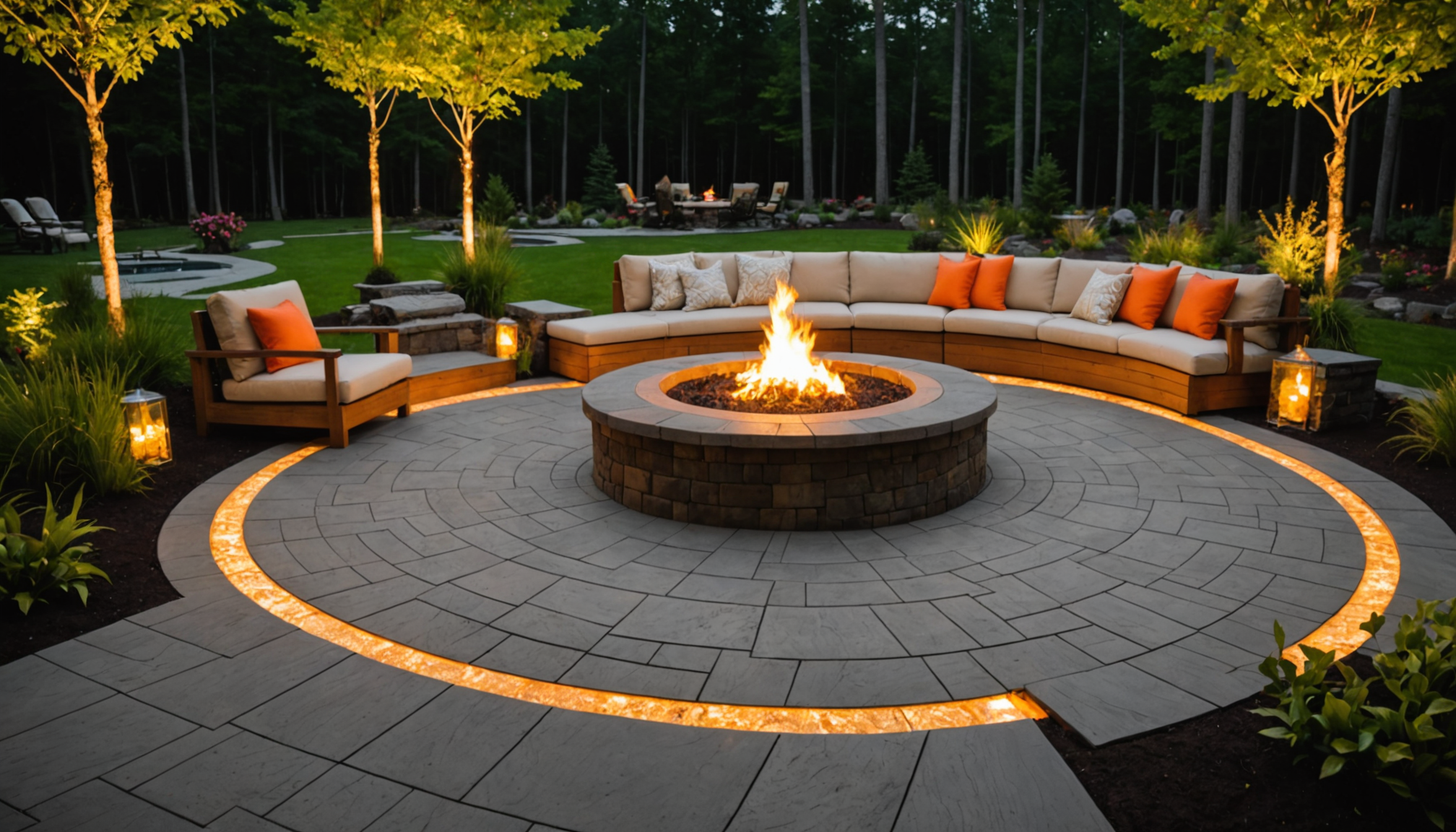When it comes to designing a stylish patio, concrete offers a versatile and durable solution that can transform an outdoor space into a sophisticated retreat. Unlike traditional patio materials such as wood or stone, concrete provides unparalleled flexibility in terms of design, color, and texture, allowing homeowners to customize their patios to reflect their personal aesthetic preferences.
The first step in creating a stylish concrete patio is selecting the appropriate type of concrete. Various techniques can be employed to achieve different looks:
- Stamped Concrete: This method involves pressing patterns into the wet concrete to mimic the appearance of brick, slate, or even wood. Stamped concrete offers an attractive alternative to genuine materials without the high cost and maintenance.
- Stained Concrete: Adding color to concrete can be achieved through staining. Acid stains offer a vibrant finish and can create a marbled effect, while water-based stains provide a wider range of color options.
- Exposed Aggregate: To create a more textured surface, the outer layer of the concrete can be washed away, revealing decorative stones and pebbles underneath. This technique not only adds visual interest but also enhances slip resistance, particularly useful around pool areas.
When designing a patio, attention to layout is crucial. Strategic planning can create distinct areas for relaxation, dining, and entertainment, maximizing the use of space. Consider utilizing features like built-in seating or focal points such as fire pits or water features to add layers of functionality and style.
Lighting is another critical component that can elevate the ambiance of a concrete patio. Installing LED lights in a variety of ways, such as embedded along pathways or around seating areas, can enhance the mood and usability of the space during evening hours.
For those looking to enhance their outdoor design using sustainable solutions, concrete can also contribute to eco-friendly practices. Incorporating recycled materials into the concrete mix or opting for permeable concrete options that allow water to seep through can reduce environmental impact. Moreover, the durability of concrete minimizes the need for frequent repairs or replacements, further conserving resources over time.
To help understand the advantages of different concrete types, consider the following comparison:
| Concrete Type | Appearance | Durability | Maintenance |
| Stamped Concrete | Mimics natural materials | High | Moderate |
| Stained Concrete | Wide range of colors | High | Low |
| Exposed Aggregate | Textured surface with pebbles | Very High | Low |
By thoughtfully selecting and handling concrete materials and incorporating creative design elements, homeowners can effectively transform their patios into stylish sanctuaries that perfectly fit their lifestyle and enhance their overall outdoor experience.
crafting decorative concrete garden elements
Crafting decorative elements for your garden using concrete can add personality and artistry to your outdoor space. With a little creativity and effort, you can create unique, durable decorations that withstand the elements. Here are some ideas and instructions for crafting decorative garden elements from concrete:
- Create Concrete Garden Sculptures:
- Start by choosing a mold for your sculpture. You can buy commercial molds or create your own using flexible materials like silicone or cardboard for basic shapes.
- Mix the concrete according to the instructions on the packaging. Aim for a smooth, pudding-like consistency that is easy to pour into molds.
- Pour the concrete slowly into your prepared mold, tapping the sides gently to release any air bubbles. This ensures a smooth finish.
- Once filled, cover the mold with plastic wrap to retain moisture and let it cure. Curing time typically ranges from 24 to 48 hours, depending on the size and volume of concrete.
- After curing, carefully remove the mold and use sandpaper to smooth out any rough edges. Your sculpture can be left as is for a natural look, or painted with weather-resistant outdoor paint for added color.
- Design Intricate Concrete Stepping Stones:
- Choose a mold or create your own using a shallow dish or baking tray lined with plastic wrap for easy removal.
- Mix the concrete as before and pour into your mold until it’s about 1 ½ to 2 inches thick, suitable for stepping stones.
- Add design elements while the concrete is wet. You can press leaves, twigs, or stones into the surface to create patterns, or write messages using a stick.
- Allow the stepping stone to cure completely before removing it from the mold. Again, curing can vary between 24 to 48 hours.
- Sand any sharp edges. Optionally, apply a coat of sealant to protect the design from the weather.
- Make Concrete Garden Orbs:
- Gather two halves of a hollow, spherical mold or use round light bulb covers as molds for smaller orbs.
- Mix your concrete to the desired consistency, ensuring it is fluid enough to fill all the curves of the mold.
- Coat the inside of the mold with a releasing agent like cooking spray, which eases the removal of the concrete once cured.
- Fill the mold with the concrete mix, ensuring it is packed tightly to prevent air pockets.
- Allow the concrete to cure. Depending on the thickness, this could take 12 to 24 hours.
- Remove from the mold, and if desired, apply a textured finish by rubbing a stiff brush over the surface. Finish with paint or a concrete sealer for added protection and style.
By experimenting with shapes, textures, and embellishments, you can create custom concrete pieces that perfectly accent your garden. The steadfast nature of concrete ensures your decorations will withstand weather and time, providing beauty and interest year-round.
building durable outdoor furniture
Concrete is renowned for its strength and longevity, making it an exceptional material for crafting outdoor furniture that can withstand the elements. When embarking on projects to create durable outdoor pieces, you’ll find concrete offers not only durability but also stylish versatility. One of the primary benefits of concrete furniture is its resistance to weather conditions; it won’t easily warp, crack, or rot compared to wood or other materials.
Start by identifying the type of furniture you wish to build, such as benches, tables, or even lounge chairs. Concrete lends itself well to modern and minimalist designs, characterized by clean lines and simple shapes. For those seeking a more customized look, concrete can also be molded into complex forms or combined with other materials like wood or metal to add contrast and warmth. By experimenting with concrete stains or adding color pigments, you can achieve a wide range of finishes—from earthy tones to vibrant hues—that fit your personal style and complement your outdoor decor.
Once the design is chosen, you can build molds using materials like plywood or melamine-coated boards, ensuring they are sturdy enough to hold the weight of wet concrete. Apply a release agent to the mold’s interior to facilitate easy removal once the concrete sets. Mixing the concrete to the right consistency is crucial; it should be thick but pourable so that it fills the mold entirely without forming air bubbles.
After pouring the concrete, you’ll need to ensure proper curing. This process can take several days depending on the thickness of the pieces. It’s important to keep the concrete covered and slightly moist during curing to prevent cracking and to achieve the maximum strength. Once cured, the pieces can be sanded to smooth any rough edges and sealed with a concrete sealer to enhance durability and maintain the finish.
Concrete furniture offers the benefit of being low-maintenance. It’s typically easy to clean with just soap and water and doesn’t require regular treatments or varnishing that wood structures might need. This makes it not only cost-effective but also environmentally friendly, as it doesn’t demand frequent replacements or repairs. Additionally, due to its inherent weight, concrete furniture provides stability, making it ideal for areas prone to strong winds.
Overall, building outdoor furniture with concrete not only leverages the material’s robustness and aesthetic versatility but also supports a sustainable lifestyle choice. Embracing concrete allows you to create distinctive, long-lasting pieces that enhance the functionality and charm of your outdoor living area.
creating unique concrete planters
When it comes to enhancing your outdoor garden aesthetic, concrete planters can serve as striking focal points, showcasing your favorite greenery and flowers. These creations blend function with design, offering a visually appealing and durable solution to house your plants. Designing your own concrete planters allows you to customize the size, shape, and texture, ensuring that your garden space truly reflects your personal taste.
To begin, you’ll need to select a mold for your concrete planter. Household items or repurposed materials, such as plastic buckets or old containers, can serve as cost-effective molds. For a more organic shape, consider using a fabric mold like an old towel or blanket, which, when soaked in concrete, hardens into a unique textured planter once cured. Remember to prepare your mold with a release agent like cooking oil or a non-stick spray to ensure easy removal once the concrete sets.
Next, mix the concrete following the manufacturer’s instructions, achieving a thick but pourable consistency. To add visual interest, consider incorporating dyes or pigments into the mix to create colorful planters that complement your garden palette. For added texture or contrast, you might introduce elements like small stones or pebbles to the exterior surface of your mold before pouring in the mixture.
Once the concrete is poured into the mold, gently tap the sides or shake the mold slightly to release any trapped air bubbles that can lead to imperfections. Allow the concrete to cure as directed—usually about 24 to 48 hours for smaller planters. Keep the mold in a shaded area and cover it with a plastic sheet to retain moisture and support an even curing process.
After the concrete has set, carefully remove it from the mold. If you wish to enhance your planter’s appearance or better match your garden’s theme, consider painting or sealing the surface for extra weather resistance. It’s also wise to drill a few drainage holes at the bottom to prevent waterlogging, a crucial step for plant health.
Custom concrete planters can accommodate various plant types, from succulents and herbs to larger shrubs, offering versatility in styling your garden. Their sturdy nature withstands harsh weather conditions, ensuring your creation will remain a steadfast feature in your outdoor space for years to come. By experimenting with different shapes and finishes, you can create a series of planters that lend a cohesive, modern aesthetic to your garden while providing practical homes for your favorite plants.
paving garden paths with concrete
Garden paths are not only functional elements of your outdoor space but also an opportunity to make a design statement. Concrete offers an excellent solution for paving garden paths, given its durability and adaptability to various styles and finishes. By choosing concrete, you ensure that your paths will withstand heavy foot traffic and varying weather conditions, maintaining their beauty over time.
The process of creating a concrete garden path begins with careful planning and design. Consider the layout — whether straight, curved, or meandering — to best complement your garden’s natural flow. Once you have a design in mind, mark out the path with stakes and string to visualize its path within your outdoor space. Ensure that the path is adequately wide for comfort and accessibility.
The next step involves preparing the ground by leveling it and removing any debris or vegetation that may obstruct a smooth surface. Excavate about 4 to 6 inches deep to create a base for the concrete. Once the ground is ready, fill the excavated area with a layer of gravel to promote drainage and prevent future shifting of the concrete. Compact the gravel thoroughly to provide a stable foundation.
As you move forward with pouring the concrete, you have several stylistic choices that can transform a simple path into a visual highlight. For an artistic touch, consider stamped designs that mimic the appearance of stone or brickwork. These textures add a traditional or rustic aesthetic to your pathways. Alternatively, expose aggregate finishes to reveal embedded pebbles or stones, offering a contrasting texture and increasing slip resistance.
Color can also play a significant role in your path’s design. Integral colorants mixed into the concrete or surface stains post-pouring allow for a wide range of hues, ensuring your path complements the surrounding landscape and architecture. Concrete dyes and stains offer flexibility in matching existing outdoor elements or creating bold focal points within your garden.
It’s vital to allow the concrete to cure appropriately; this generally takes around seven days for partial curing and up to a month for full curing, depending on the environment and humidity levels. During this time, keep the concrete moist to prevent cracking—covering it with burlap and occasionally misting it helps maintain the necessary moisture levels.
Once your path is complete and thoroughly cured, maintain it by cleaning with water and a mild detergent. This upkeep prevents dirt and algae buildup, maintaining the path’s appeal and functionality. With concrete paths, you can seamlessly connect different areas of your garden, guiding visitors through an attractive and cohesive landscape design.
Incorporating concrete into your outdoor design opens a world of creative possibilities, transforming mundane spaces into distinctive, inviting environments. Whether crafting robust furniture, unique planters, decorative garden elements, or paving pathways, concrete proves to be a versatile and durable choice suitable for any style. This enduring material accommodates a variety of designs, textures, and colors, allowing homeowners to achieve their desired aesthetic while enjoying the benefits of low maintenance and longevity. By embracing concrete’s potential, you can elevate your outdoor space into a stylish, functional retreat that thrives over time.


